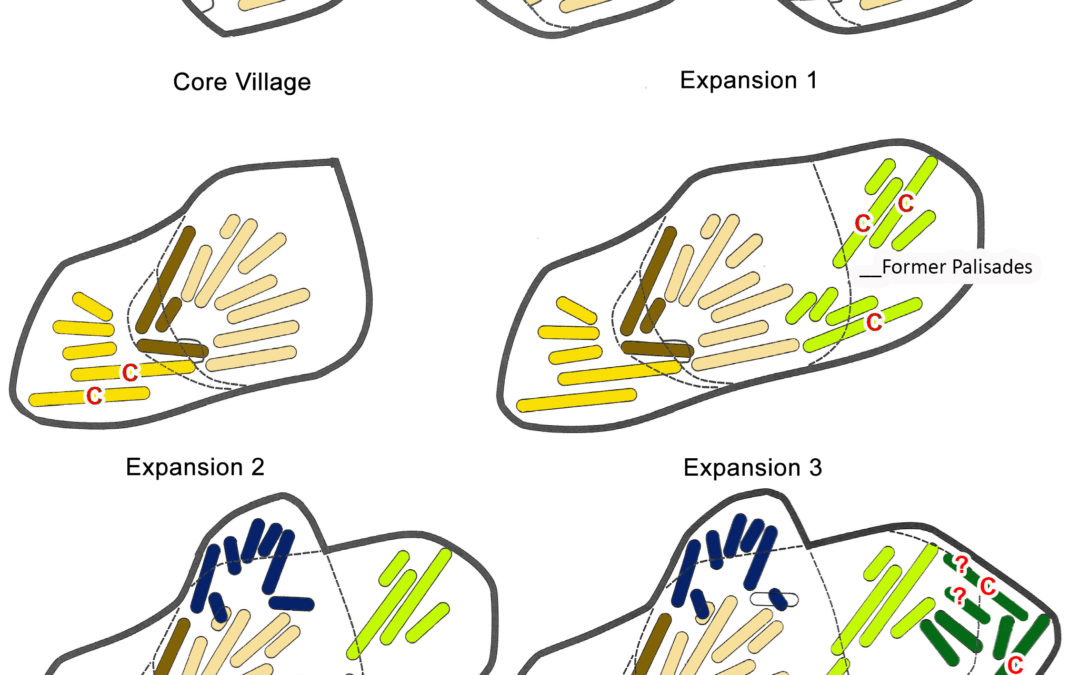In my last blog, I discussed the presence of three buildings which I believed to be special structures to house visitors to the Draper site, providing accommodation but restricting visitors access to the entire village and its layout. This continuing discussion is based on houses in the Main Village. In a future blog, we’ll explore the South Field houses as well.
For now, we’ll focus on another group of houses which were present within the Draper site. I have interpreted most of these as longhouses which were occupied by chiefs. We know from the historical documents of the Historic Huron that these types of houses existed. And while I believe the occupants of the Draper site were Ontario Iroquoians and not ancestral Hurons, we can still use historical data on the Huron to help us better understand the occupants of the Draper site.
For the Huron, the chiefs inhabited bigger houses and we know that there were sometimes two chiefs in a village, a war chief and a civil chief. The former dealt with matters of warfare with other groups and the latter dealt with matters relating to the village.
At the Draper site, there were a number of longhouses which were longer than the rest of those in the village. For the Core Village, the two longest longhouses were located toward the centre of the village and these could represent chiefs’ houses. For Expansion 1, the new single long longhouse was located parallel to the palisades and may represent a single chief’s house for this small addition. For Expansion 2, the two long longhouses were situated beside each other and parallel to the palisades and again may have been two chiefs’ houses. Interestingly, for Expansion 3, there were three long longhouses, although since there were two clusters of houses of different orientation, perhaps two different groups joined the village at this time, and one had a single chief, the other had two chiefs. For Expansion 4, the longest longhouses were maintained at the outer edges of the expansion, although given the spatial constraints in this area, these need not have been chiefs’ houses either. For Expansion 5, the longest longhouse was again positioned parallel to the palisades and I believe it possible that a similar long longhouse had been placed parallel to the palisades along the eastern side of this expansion which had unfortunately been subsequently destroyed.
It is noteworthy that as the village expanded, these long longhouses were situated on the outer edges of the expanded part of the village. As such, I believe that they were strategically placed there to be part of the village defenses. In this respect, if a war party breached the palisades, these long structures would have provided a second line of defense by limiting access to the interior parts of the village.
Such a pattern of placement of chiefs’ houses to assist in village defenses may be unique to the Draper site. This represents yet another confirmation of the need for more research to better understand these Iroquoian peoples who occupied Draper in the 16th century.
Thanks very kindly for your engaging comments and questions among our growing Facebook community and here on Our Lands Speak blog.
Bill Finlayson
William D. Finlayson, Midland, Ontario
Ontario’s Leading and Senior-Most Archaeologist and Author
Founder of Our Lands Speak Book Series and Occasional Papers in Ontario Archaeology
Feature image: Plan of the Draper Site showing Chiefs’ Houses in Different Segments of the Village (working version 2, Feb. 3, 2020)
All rights reserved. The use of any part of this publication reproduced, transmitted in any form or by any means, electronic, mechanical, photocopying, recording, or otherwise, or stored in a retrieval system, without the prior written consent of the author and publisher is an infringement of the copyright law. To that end, every attempt has been made to give proper acknowledgement, and access appropriate permissions for quotes. Any oversights are purely unintentional. In the unlikely event something has been missed, please accept our regret and apology, and contact us immediately so we can investigate and rectify as needed. All of the quantitative factual information is recorded in various published and unpublished sources and can be provided upon request.
